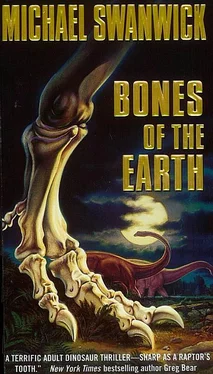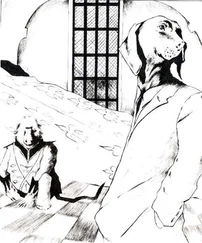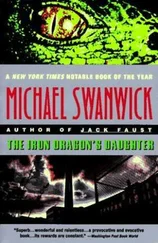Michael Swanwick
Bones of the Earth
This book is dedicated to all good teachers everywhere, most particularly those of the William Levering School and Central High School in Philadelphia, to whom more is owed than can ever be repaid.
Special thanks are due to Ralph Chapman, Linda Deck, Tom Holtz, Pete Tillman, and Bob Walters for giving generously of their time and knowledge. They are, of course, not responsible for any errors I may have made, just as I am not responsible for anything rendered invalid by discoveries they or their colleagues may make after this book reaches print. I am also grateful to Harry Turtledove for help with Greek nomenclature, to Suzette Haden Elgin for management strategies of the Lakota Sioux, to Charles Sheffield for the future history of the Earth, to William Gibson for the Rolex Milgauss (nice watch, Bill!), and to my favorite goddaughter in the known universe, Alicia Ma, for naming Lai-tsz. I am most indebted, as always, to the M.C. Porter Endowment for the Arts, most particularly for help writing the abstract for the infrasound paper.

Washington, D.C.: Cenozoic era. Quaternary period. Holocene epoch. Modern age. 2010 C.E.
If the whole tangled affair could be said to have a beginning at all, it began on that cold, blustery afternoon in late October when the man with the Igloo cooler walked into Richard Leyster’s office. His handshake was firm, and he set the cooler casually down on a tabletop between a lime-green inflatable tyrannosaur and a tray of unsorted hadrosaur teeth without asking permission first. His smile was utterly without warmth. He said his name was Griffin and that he had come to offer Leyster a new position.
Leyster laughed and, sitting back on the edge of his desk, put down the man’s card without looking at it. “You could hardly have chosen a worse time to make the offer.”
“Oh?” Griffin shifted a stack of AutoCAD boxes from a chair to the floor. His suit was expensive; he tugged at the knees as he sat, to protect the cloth. He had a heavy, inexpressive face. “Why is that?”
“Well, to begin with, the Smithsonian gave me my current position while I was still finishing up my doctorate. That’s one hell of an honor, and I’d look pretty damn ungrateful to move on after less than three years service. I realize you’re offering more money—”
“I haven’t mentioned salary yet.”
“The Smithsonian is acutely aware of what an honor it is to work for them,” Leyster said dryly. “One of our technicians moonlights selling beer at Orioles games. Guess which job pays him more?”
“There are other inducements besides money.”
“Which is precisely why you’re wasting your time. I was on a dig this summer in Wyoming where we uncovered a trackway that’s just… well, it’s the sort of find that comes along once in a lifetime— if you’re lucky. Whatever you’re offering couldn’t possibly be worth my walking away from it.”
For a long moment, Griffin said nothing. Swiveling in his chair, he stared out the window. Following his gaze, Leyster saw only the dark sky, the slick orange tiles on the rooftops opposite, the taxis throwing up gray rooster tails behind themselves on Constitution Avenue, the wet leaves clinging to the glass. Then, turning back, Griffin asked, “Could I see?”
“Do you really want to?” Leyster was surprised. Griffin didn’t seem the sort to be interested in original research. A bureaucrat, an arranger, an organizer, yes. A politician, possibly. But never a scientist. Griffin hadn’t even arranged for this meeting as a scientist would, with the name of a mutual colleague and his professional affiliation held high, but through the administrative apparatus of the Museum. Some apparatchik, he couldn’t even remember who, had called and said that somebody had applied pressure to somebody else up the line, and, figuring it was easier to take the meeting than hear out the explanation, he’d said he’d do it.
“I wouldn’t ask if I didn’t.”
With a mental shrug, Leyster booted up first his computer and then the trackway program, routing the image to a high-density monitor hung on the wall. The image was as detailed as modern technology could make it. He had provided multiple photographs of each track and Ralph Chapman, down the hall, had come up with a 3-D merge-and-justify routine for them. The program began at the far end of the trackway.
“What do you see?” he asked.
“Footprints,” Griffin said, “in mud.”
“So they were, once. Which is what makes them so exciting. When you dig up fossil bones, that’s the record of a dead animal. But here, this—this was made by living animals. They were alive and breathing the day they made these, and for one of them it was a very significant day indeed. Let me walk you through it.”
He held one hand on the trackball, so he could scroll through the program as he talked. “One hundred forty million years ago, an Apatosaurus—what used to known as Brontosaurus, before the taxon was reattributed—is out for a stroll along the shores of a shallow lake. See how steady the apatosaur’s prints are, how placidly it ambles along. It is not yet aware that it’s being hunted.”
Griffin gravely folded his hands as Leyster scrolled down the trackway. They were enormous hands, even for a man of his bulk, and strangely expressive.
“Now look at these smaller sets of prints here and here, coming out of the forest and following along to either side of the apatosaur’s prints. These belong to a hunting pair of Allosaurus fragilis. Killer dinosaurs twelve meters long, with enormous sharp claws on their hands and feet, and teeth as large as daggers but with a serrated edge. They move more swiftly than their prey, but they’re not running yet—they’re stalking. Notice how they’ve already positioned themselves so they can come up on it from either side.
“Here, the apatosaur becomes aware of its danger. Perhaps the wind shifts and it smells the allosaurs. Maybe the creatures scream as they attack. We’ll never know. Whatever alerted it left no trace in the fossil record.
“It runs.
“See how the distance between strides increases. And see how back here, the same thing happens to the allosaur tracks. They’ve gone into an all-out sprint. They’re charging, much like a lion charges its prey. Only, their prey is as big as a mountain and they themselves are so large and fierce they could eat lions for breakfast.
“Now look, see how there’s a little skip here in the one allosaur’s tracks, and an identical one here in the other’s. They’re matching strides with the apatosaur. For the rest of the chase, they’re all three running in lockstep. The allosaurs are in position to leap.”
He was paying no attention at all to his auditor now, caught up once again in the drama of the fossil. Life pursued by death. It was an experience common to all creatures, but somehow it always came as a surprise when it actually happened.
“Could the apatosaur outrun them? It’s possible. If it could get up to speed quickly enough. But something that big simply can’t accelerate as fast as the allosaurs can. So it has to turn—here, where the three tracks converge—and fight.”
He double-clicked the trackball’s right button to zoom up so that they could see a larger area in the screen.
“This is where things get interesting. Look how confused the trackway is—all these trampled places, all this churned-up mud. That’s what makes this fossil unique. It’s the actual record of the fight itself. Look at those footprints—hundreds of them!—where the apatosaur is struggling with its attackers. See how deep these paired footprints are? I haven’t worked out the ergonomics yet, but it’s possible the brute actually rears up on its hind legs and then falls forward again, trying to crush its tormentors. If it can only take advantage of its immense weight, it can still win the battle.
Читать дальше







